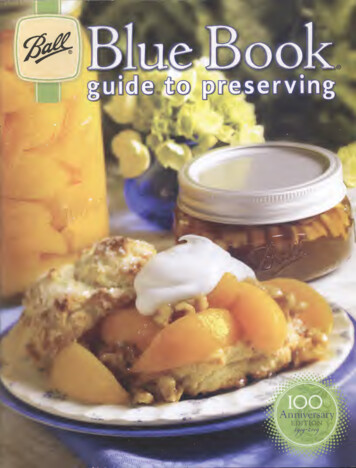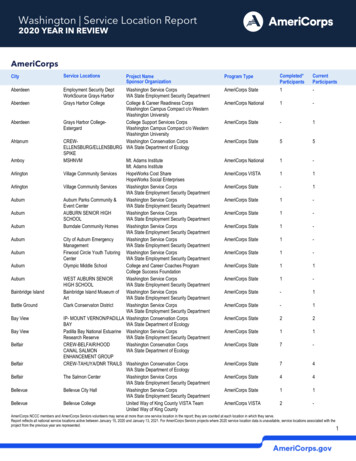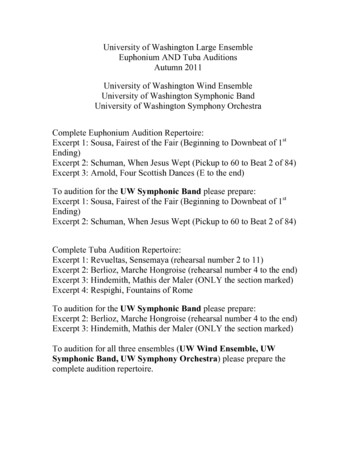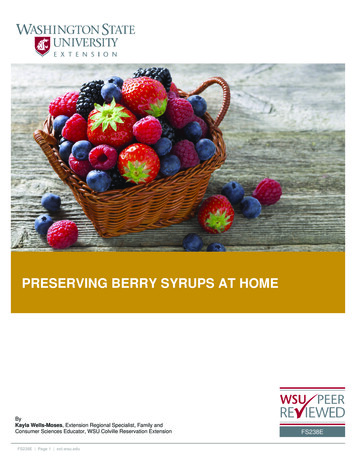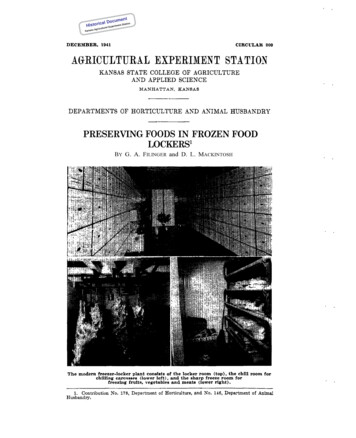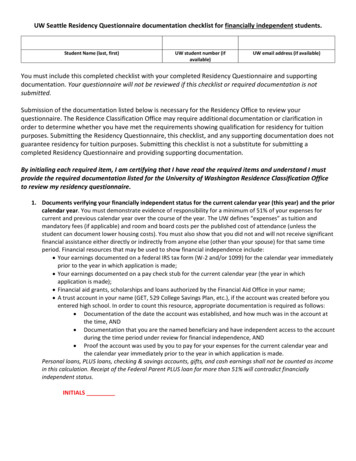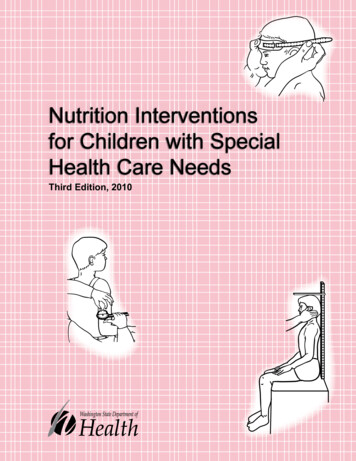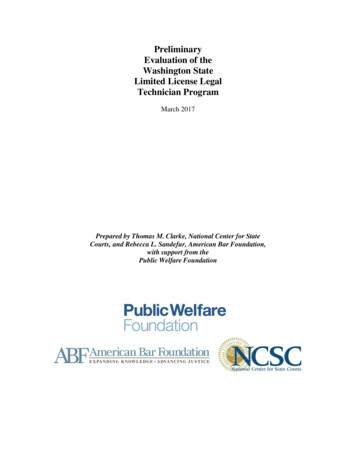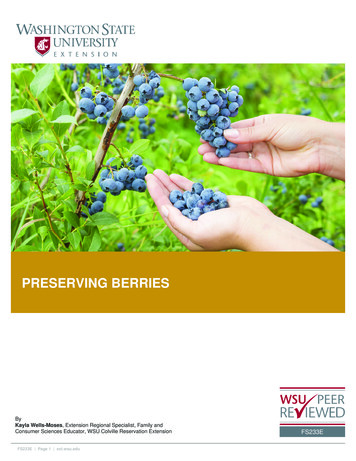
Transcription
PRESERVING BERRIESByKayla Wells-Moses, Extension Regional Specialist, Family andConsumer Sciences Educator, WSU Colville Reservation ExtensionFS233E Page 1 ext.wsu.eduFS233E
WSU EXTENSION PRESERVING BERRIESPreserving BerriesAbstractFresh berries can be preserved for long-term storage bycanning, freezing, and dehydrating. Before deciding whichmethod to use for preserving fresh berries, it is best todetermine how you plan to use them. Berries can be cannedwhole, as fruit spread, as syrup, or as pie filling. Berries can bepre-treated with sugar or syrup before freezing, or processedwithout pre-treatment prior to freezing. For dehydrating,berries can be dried whole, as slices, or as fruit leather. Thispublication will teach the essential steps for preserving freshberries through the processes of canning, freezing, anddehydrating.Preserving BerriesAssorted berries; picked at the peak of ripeness for optimal flavor.Berries of the Pacific NorthwestA variety of berries can be found in the Pacific Northwest. Thelist of berries that grow abundantly in the Pacific Northwest isextensive. Some popular berries include: blackberries,blueberries, boysenberries, chokecherries, currants,dewberries, elderberries, gooseberries, grapes, huckleberries,loganberries, marionberries, mulberries, salmonberries,strawberries, raspberries and youngberries. Depending on thetype, berries can be ready for harvest in the late spring, withsome seasons stretching until late fall. If you are seeking moreinformation about the availability of specific berries in yourarea, contact your local Extension Office.Harvesting blueberries.General InformationQuantityBerries can be preserved by canning, freezing, or dehydrating.Berries can be canned whole, made into fruit spread, turnedinto syrup, or used in pie fillings. Berries can be frozen dry(not pre-treated), with sugar, or in syrup. Berries can bedehydrated whole, as slices, or pureed into fruit leather. Whenchoosing how to preserve berries, it is best to determine howyou are going to use them before preserving them.The exact quantity of berries you needed depends on the sizeand variety of the berry. Following is a rough estimate:HarvestingSince berries lose their freshness quickly in the heat, it is bestto pick them in the coolness of the early morning. Oncepicked, place berries in the shade or refrigerator. Berriesshould not be washed until just before using or preservingthem.FS233E Page 2 ext.wsu.edu2 lbs. of fresh berries will yield 1 quart of frozen orcanned berries.1 quart of fresh berries will yield approximately 1 cupof juice for jelly or 2 cups of mashed berries for jamsand other fruit spreads.A 36 lb. crate of whole berries will yield approximately18-24 quarts.About 12 pounds of berries are needed to fill 7 quartsfor canning.About 8 pounds are needed to fill 9 pints for canning.
WSU EXTENSION PRESERVING BERRIESCanning Whole BerriesBerries are high in acid so they can be canned using a boilingwater bath canner. All varieties of berries, except strawberries,can be canned whole. Unfortunately, home cannedstrawberries become mushy and lose their color and flavor.When canning whole, the following berries produce thehighest quality canned products: blackberries, blueberries,boysenberries, currants, dewberries, elderberries,huckleberries, loganberries, marionberries, mulberries,raspberries, and youngberries.When canning without added sugar, berries can be canned intheir natural juices or in water. When canning using addedjuice, either extract juice from berries or add unsweetened fruitjuice. Juice can be extracted from a portion of the fruit to becanned, or from fresh apples, pineapple, or white grapes.To extract juice from berries:1. Crush the ripe, unbruised fruit.2. Heat to simmer over low heat.3. Strain through a cheesecloth or jelly bag.Canned whole cherries.Preparing Whole Berries for CanningTo prepare whole berries for canning, follow the steps below:Extracting berry juice.1. Choose ripe, sweet berries with uniform color.2. Wash 1 to 2 quarts of berries at a time.3. Remove cap and stem, if necessary. (For gooseberries,snip off heads and tails with scissors.)4. Berries may be canned in their natural juices, in water,or in syrup.FS233E Page 3 ext.wsu.eduA steam juicer may also be used to extract juice. Followmanufacturer instructions when using a steam juicer, or contactyour local Extension office for more information.If using unsweetened fruit juice, canning fruit in its own juiceproduces the best results. Commercial, unsweetened applejuice, pineapple juice, or white grape juice may also be addedto canned berries, if not enough natural juices are extracted.
WSU EXTENSION PRESERVING BERRIESBerries will hold their shape and color better if canned in eithernatural juices or syrup. To make syrup, boil the amount ofsugar and water recommended in Table 1. Table 1 shows theproportions of water and sugar needed to create enough syrupfor 9 pints of whole berries.Table 1. Proportions of Sugar and Water for SyrupCanning Whole Berries Using theHot Pack MethodCanned whole berries can either be hot packed or raw packed.You can usually fit more berries in the jars by using the hotpack method. Raw packed berries may have a tendency to float.To hot pack whole berries:Some of the equipment and accessories that are helpful for home canning.Boiling water bath canner loaded with jars.FS233E Page 4 ext.wsu.edu1. Bring water, syrup or juice to a boil.2. Add berries to the boiling liquid for 30 seconds.3. Fill hot jars with hot berries and cover with the hotliquid, leaving ½ inch headspace. (Headspace is thedistance between the bottom of the lid and the productin the jar.)4. Remove bubbles by inserting a bubble freer or anyplastic or rubber knife-like utensil at the edge of the jarand gently shifting the food around to release anytrapped air. Re-measure and adjust headspace by addingliquid, if needed. (Do not use a metal utensil forremoving bubbles, as the metal can scratch and weakenthe jar.)5. Thoroughly wipe jar rim and threads with a clean, damppaper towel.6. Cover with lid and band, tighten band to “fingertiptight.”7. Load jars into the canner using a jar lifter and keep thejars upright at all times.8. If water does not cover jars by 1 to 2 inches, add moreboiling water to the canner.9. Turn heat to the highest setting, cover the canner withthe lid, and heat until the water boils vigorously.10. Once the water reaches a full rolling boil, start yourtimer for the recommended number of minutes (Table2), making sure to adjust for altitude. Make sure thewater in the canner remains boiling throughout theentire processing time.11. When timer goes off, turn off the heat, remove thecanner lid and allow jars to sit for 5 minutes.12. After 5 minutes, remove jars with a jar lifter, keepingthe jars upright at all times. Place jars on a drying rackand allow to cool for 12-24 hours.13. When cool, check for seals, label, date and store in acool, dark place. To check jars for seal, listen for the“popping” sound during cooling. Lids are sealed if theyare curved downward in the center and do not movewhen pressed on. Another way to test for seal is bytapping the center of the lid with a spoon. Sealed lidsproduce a clear, ringing sound.
WSU EXTENSION PRESERVING BERRIESCanning Whole Berries Using theRaw Pack MethodFollowing are instructions for raw packing whole berries forcanning:1. Fill hot jars with clean, raw berries, shaking downgently while filling.2. Cover with hot juice, water, or syrup, leaving ½ inchheadspace.3. Remove bubbles and adjust headspace, if needed.4. Thoroughly wipe jar rim and threads with a clean, damppaper towel.5. Cover with lid and band, tighten band to “fingertiptight.”6. Load jars into the canner using a jar lifter and keep thejars upright at all times.7. If water does not cover jars by 1 to 2 inches, add moreboiling water to the canner.8. Turn heat to the highest setting, cover the canner withthe lid, and heat until the water boils vigorously.9. Once the water reaches a full rolling boil, start yourtimer for the recommended number of minutes, makingsure to adjust for altitude (Table 2). Make sure thewater in the canner remains boiling throughout theentire processing time.10. When timer goes off, turn off the heat, remove thecanner lid and allow jars to sit for 5 minutes.11. After 5 minutes, remove jars with a jar lifter, keepingthe jars upright at all times. Place jars on a drying rackand allow to cool for 12-24 hours.12. When jars are completely cool, check lids for seal. Tocheck jars for seal, listen for the “popping” soundduring cooling. Lids are sealed if they are curveddownward in the center and do not move when pressedon. Another way to test for seal is by tapping the centerof the lid with a spoon. Sealed lids produce a clear,ringing sound.13. Remove ring bands from sealed jars to prevent rusting,clean jars and lids, label, and store in a cool, dry placeout of direct light.14. What if jars don’t seal? You have three choices:Put in the refrigerator and use immediately.Put in the freezer.Re-process within 24 hours. Remove the lid andcheck the jar sealing surface for tiny nicks. Ifnecessary, change the jar, add a new treated lid,and reprocess using the original processing time.If jar(s) unseal after 24 hours, productmust be thrown away.Other Canned Products using BerriesFresh berries can also be made into jams, jellies, spreads, andsyrups, and then canned or frozen. Fresh and frozen berries canalso be made into pie fillings using a modified food starchcalled Clear-Jel as a thickening agent, and canned in a boilingwater bath canner. For research-based recipes for jams, jellies,spreads, syrups and pie fillings, contact your local ExtensionOffice or refer to the National Center for Home FoodPreservation.Freezing Fresh Pacific NorthwestBerriesIf you have not determined how you are going to use yourpreserved berries, freezing is a good option. Berries can befrozen untreated, coated with sugar, or in syrup. Berries frozenuntreated can be used to make jams, jellies, pies, syrups andother baked goods. Frozen berries should be stored below 0 Fand used within 1 year for best quality.Frozen mixed berries.Table 2. Recommended Process Times for Whole Berries in a Boiling Water Bath Canner, Adjusting for AltitudeFS233E Page 5 ext.wsu.edu
WSU EXTENSION PRESERVING BERRIESTo freeze untreated berries:1.2.3.4.5.Wash.Drain well.Place in single layer on a baking sheet.Place baking sheet in freezer.Freeze until berries are firm, then package frozenberries in freezer bags or containers. Freezing berriesfirst on a cookie sheet keeps them from sticking to eachother inside another container.6. Label and date container or bag.To freeze berries in sugar:1. Wash the berries.2. Drain.3. Sprinkle with sugar. The amount of sugar used willdepend on personal preference and taste.4. Let berries and sugar sit until sugar is completelydissolved.5. Package sugared berries in freezer bags or containers.6. Freeze sugared berries.7. Label and date container or bag.Freezing berries in syrup will help the berries retain theirfirmness.To freeze berries in syrup:1. Choose a syrup from Table 1 and prepare following thecanning directions.2. Allow the syrup to cool.3. Place washed and drained berries loosely in freezercontainers.4. Cover with the cold syrup, leaving 1-inch headspace.To hold berries under the liquid in the containers, placea piece of crumbled plastic wrap on top of the berries.5. Place berries and syrup in freezer.Dehydrating Fresh Pacific NorthwestBerriesDrying is one of the oldest methods of food preservation.Dried foods are lightweight, take up little storage space, and donot need to be refrigerated. Dried berries are tasty andnutritious. They may be sweeter than fresh berries because thedehydrating process removes the water and concentrates theflavor.Follow these steps for dehydrating fresh berries:1. Select firm, ripe berries that have a solid color.2. Wash berries, remove stems, and drain well.FS233E Page 6 ext.wsu.eduFruit and berry slices on a dehydrator tray.3. Dehydrate smaller berries, like blueberries, whole.Larger berries, like strawberries, should be cut into ½inch slices.4. Place berries close, but not touching, on trays. This isthe same rule for the trays used in dehydrator dryingand cookie sheets used for oven drying. Contact yourlocal Extension office if you want information onconvection oven drying, sun drying, or solar drying ofberries.5. Follow the manufacturer’s instructions for dryingtemperature and times, or contact your local Extensionoffice to get instructions on using a dehydrator or ovenfor drying berries.Most berries can be dried without pre-treatment. Berries likeblueberries should be pre-treated by dipping in boiling water tocrack their skins before dehydrating. Fruits are dry when theyare leathery and pliable with no pockets of moisture. Driedberries are excellent eaten as a snack or added to cereal, bakedproducts, or pancakes. Dried berries are best eaten driedbecause they lose their firm texture when rehydrated.Blackberries and raspberries are not recommended fordehydrating because of their high seed content and slow dryingtime. However, they do make excellent dried fruit leathers.Making and Dehydrating FruitLeathersFruit leathers can be made using fresh berries, canned berries,or frozen berries. Berries can be pureed by themselves, or incombination with other fruits, to make fruit leathers. Contactyour local Extension office for fruit leather recipes. Since fruitseeds become hard after they dry, it is best to remove the seedsfrom the puree, using a mesh strainer or food mill, prior todehydrating.
WSU EXTENSION PRESERVING BERRIESTo make fruit leathers:1. Puree berries.2. Remove seeds by pushing pureed berries through a finemesh sieve, collecting the berry pulp in a bowl, anddiscarding the seeds. This step is optional, and it isdifficult to completely remove all the seeds from thepulp.3. Sweeten to taste.4. Pour on a specially-designed liner for leather dryingusing a dehydrator. For oven drying, cover a cookiesheet with a non-stick material, like plastic wrap. Donot use waxed paper or aluminum foil.5. Follow the manufacturer’s instructions for dryingtemperature and times, or contact your local Extensionoffice to get instructions on using a dehydrator or ovenfor dehydrating fruit leathers.Fruit leathers are finished when they are leathery with nomoisture pockets. When fruit leather is done, remove fromdrying tray and roll or cut into bite size pieces.Storage of Dehydrated Berries andFruit LeathersStore dehydrated berries and fruit leathers in moisture-proofcontainers. Containers that are appropriate for freezing workwell for storing dried foods, too. Food-grade plastic freezerbags, glass jars with lids and plastic containers with lids areexamples of acceptable storage containers.FS233E Page 7 ext.wsu.eduFurther ReadingGarden-Robinson, J. and J. Hegerfield-Baker. 2015.Food Preservation: Home Canning Fruit and Fruit Products.North Dakota State University Extension Publication FN174.OSU Extension. 2013. Preserving Foods: Berries. OregonState University Extension Publication SP 50-780. OregonState University.Powers-Hammond, L. and S. McCurdy. 2015. Fundamentalsof Consumer Food Safety and Preservation: MasterHandbook. Washington State University.Schafer, W. and S. Driessen. 2015. Preparing and UsingSyrups for Preserving Fruits. University of MinnesotaExtension Publication. University of Minnesota.UGA Extension. 2009. Selecting, Preparing and CanningFruit. United States Department of Agriculture Publications,National Center for Home Food Preservation. University ofGeorgia.WSU Extension. 2004. Berries for the Inland Northwest.Washington State University.
WSU EXTENSION PRESERVING BERRIESCopyright 2016 Washington State UniversityWSU Extension bulletins contain material written and produced for public distribution. Alternate formats of our educationalmaterials are available upon request for persons with disabilities. Please contact Washington State University Extension for moreinformation.Issued by Washington State University Extension and the U.S. Department of Agriculture in furtherance of the Acts of May 8 andJune 30, 1914. Extension programs and policies are consistent with federal and state laws and regulations on nondiscriminationregarding race, sex, religion, age, color, creed, and national or ethnic origin; physical, mental, or sensory disability; marital statusor sexual orientation; and status as a Vietnam-era or disabled veteran. Evidence of noncompliance may be reported through yourlocal WSU Extension office. Trade names have been used to simplify information; no endorsement is intended. PublishedSeptember 2016.FS233E Page 8 ext.wsu.edu
When canning without added sugar, berries can be canned in their natural juices or in water. When canning using added juice, either extract juice from berries or add unsweetened fruit juice. Juice can be extracted from a portion of the fruit to be canned, or from fresh apples, pineapple, or white grapes. To extract juice from berries: 1.
